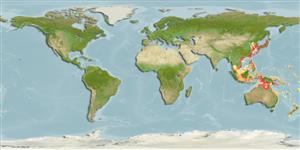Environment: milieu / climate zone / depth range / distribution range
বাস্তুসংস্থান
সামুদ্রিক তলদেশ বিহারী; গভীরতার পরিসীমা 10 - 64 m (Ref. 86942). Temperate
Western Pacific: Japan (from Matsushima Bay and Niigata Prefecture southward) and southern coast of the Korean Peninsula. Recently reported from the Chesterfield Islands (Ref. 11897).
আকৃতি / ওজন / Age
Maturity: Lm ? range ? - ? cm
Max length : 12.0 cm TL পুরুষ/ লিঙ্গ অনিধর্ারিত ; (Ref. 559); সবের্াচ্চ প্রকাশিত ওজন : 23.40 g (Ref. 112063)
পৃষ্ঠীয় কাঁটা (মোট ): 10 - 13; পৃষ্ঠীয় নরম পাখনা দন্ড (মোট ): 10-14; পায়ূ কাঁটা 1; পায়ূর নরম পাখনা্তুন্ড: 11 - 13. Body ovoid and compressed, covered with velvety prickles. Preoperculum with 4 spines. Dorsal fin notched behind the 3rd spine. Body dark-brown with indefinite darker blotches.
Occurs in shallow waters on sand or mud bottoms. Processed into animal feeds and fertilizers (Ref. 637). Neither anterolateral glandular groove nor venom gland is present (Ref. 57406).
Life cycle and mating behavior
পরিপক্কতা | প্রজনন | ডিম ছাড়া | ডিমসমূহ | ডিম্বধারন ক্ষমতা | শুককীট
Masuda, H., K. Amaoka, C. Araga, T. Uyeno and T. Yoshino, 1984. The fishes of the Japanese Archipelago. Vol. 1. Tokai University Press, Tokyo, Japan. 437 p. (text). (Ref. 559)
IUCN Red List Status (Ref. 130435)
Threat to humans
Harmless
Human uses
আরো তথ্য
প্রচলিত নাম সমূহপ্রতিনাম সমূহবিপাকশিকারী প্রাণী সমূহপরিবেশ বিষাক্ততাবিদ্যাপ্রজনন পরিপক্কতা ডিম ছাড়া ডিমের সংগ্রহ ডিম্বধারন ক্ষমতা ডিমসমূহEgg development
সূত্র সংখ্যা এ্যাকুয়াকালচার (জলজ পালন) এ্যাকুয়াকালচার নকশা বংশ বংশানুগতিবিদ্যাElectrophoresesউতরাধিকার সুত্রে পাওয়া যোগ্যতারোগ প্রক্রিয়াজাতকরণ NutrientsMass conversion
সহযোগী ছবি সমূহStamps, Coins Misc.শব্দ ক্রোমোজোমের ধরণ গতি সাতাঁরের কায়দা ফুলকা এলাকাOtolithsমস্তিস্ক সমূহদৃষ্টি
হাতিয়ার
Special reports
Download XML
ইন্টারনেট সুত্র
Estimates based on models
Preferred temperature (Ref.
123201): 20.5 - 29, mean 28 °C (based on 554 cells).
Phylogenetic diversity index (Ref.
82804): PD
50 = 0.5625 [Uniqueness, from 0.5 = low to 2.0 = high].
Bayesian length-weight: a=0.00389 (0.00180 - 0.00842), b=3.12 (2.94 - 3.30), in cm total length, based on all LWR estimates for this body shape (Ref.
93245).
ট্রফিক পর্যায়ে (Ref.
69278): 4.1 ±0.47 se; based on food items.
Fishing Vulnerability (Ref.
59153): Low vulnerability (10 of 100).
